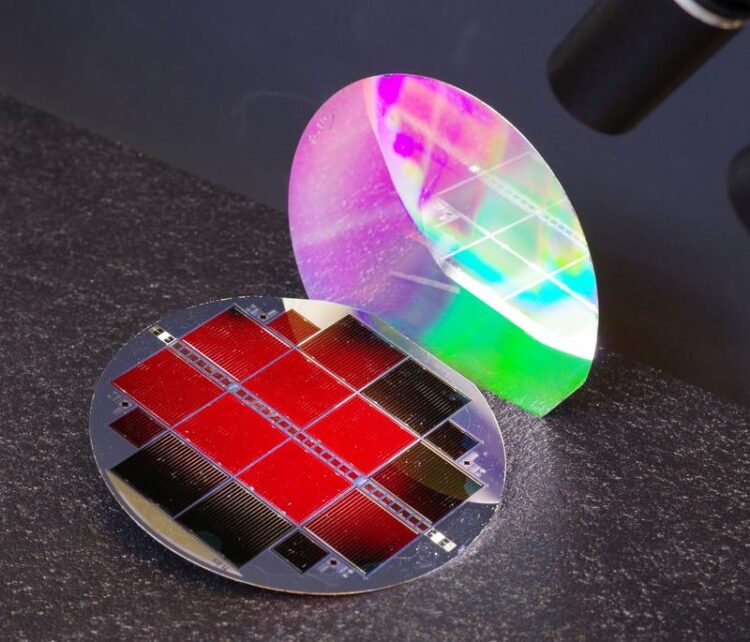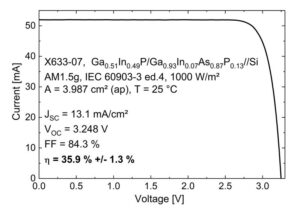Tandem Photovoltaics Enables New Heights in Solar Cell Efficiencies

The new III-V//Si tandem solar cell with 35.9 % efficiency. The top subcell glows red, which is a sign of outstanding material quality. The nanostructured back side of the cell shimmers in rainbow colors.
Michael Schachtner / © Fraunhofer ISE
35.9 % for III-V//Silicon Solar Cell …
Fraunhofer ISE has been conducting cutting-edge research in photovoltaics for forty years. Continually the institute has brought forth record cell efficiencies in different material classes and made important contributions in reducing the costs of solar electricity, which is the cheapest form of energy generation today. Photovoltaics, along with wind energy, is the central pillar of the energy transition. Aiming to further reduce the area required for PV installations as well as material use, Fraunhofer ISE is focusing on tandem photovoltaics. This cell technology allows the traditional efficiency limits to be exceeded by selectively combining different solar cell materials.
The Freiburg researchers have again succeeded in setting a new world record with a monolithic tandem cell made of III-V and silicon semiconductors.

© Fraunhofer ISE
The new monolithic triple-junction solar cell – or more specifically, a III-V//Si tandem solar cell – converts 35.9 % of sunlight into electrical energy. This value measured under the terrestrial AM1.5g spectrum, sets a new world record and demonstrates the potential of silicon-based tandem photovoltaics. In the new record-breaking cell, the III-V semiconductor layers are connected directly to the silicon sub-cell on the atomic level. From the outside, the record cell resembles a two-terminal conventional solar cell. This two-terminal cell achieves the same efficiency as the best four-terminal solar cells with mechanically stacked structures, as published jointly by NREL, CSEM and EPFL in 2017.
“The use of a new compound semiconductor (GaInAsP) for the middle cell was a key step in our success in achieving the improved efficiency value,” says Patrick Schygulla, doctoral student in the Department of III-V Photovoltaics and Concentrator Technology at Fraunhofer ISE. “The new material allowed us to further improve the lifetime of the charge carriers and thus achieve a higher cell voltage. It’s great to see how our material development has successfully contributed to improvements in III-V//Si triple-junction solar cells.”
Initial applications for high efficiency III-V//Si tandem cells are found where the power generation per area plays an important role, for example, in electrically powered aircraft and drones. Today, the production costs of the new cells are still significantly higher than conventional single-junction crystalline silicon solar cells. This is due to the complex epitaxy step of the III-V layers and the many additional semiconductor processes required to manufacture the cells. The researchers at Fraunhofer ISE are working intensively to make the production more cost-effective in the future and thus also address the terrestrial photovoltaic market.
“Combining III-V semiconductor materials on silicon is one of the approaches that we are pursuing with tandem structures (i.e., the combination of different high-performance materials) in order to achieve higher solar cell efficiencies,” explains Prof. Andreas Bett, institute director of Fraunhofer ISE. “It will be a few years before any PV modules made from the type of solar cell presented here are available on the market; however, this is an important, forward-looking path in the context of the photovoltaic expansion which is necessary for a sustainable energy supply.”
The development of the III-V//Si tandem solar cells was funded by the German Federal Ministry for Economic Affairs and Energy BMWi in the project PoTaSi – “Demonstration of the Potential of Monolithic Tandem Solar Cells Made of III-V Semiconductors and Silicon” (https://www.ise.fraunhofer.de/en/research-projects/potasi.html) as well as through a doctoral stipend from the Heinrich Böll Foundation.
Weitere Informationen:
https://www.ise.fraunhofer.de/en/key-topics/tandem-photovoltaics.html
https://www.ise.fraunhofer.de/en/business-areas/photovoltaics/iii-v-and-concentr…
https://www.ise.fraunhofer.de/en/business-areas/photovoltaics/iii-v-and-concentr…
Media Contact
All latest news from the category: Power and Electrical Engineering
This topic covers issues related to energy generation, conversion, transportation and consumption and how the industry is addressing the challenge of energy efficiency in general.
innovations-report provides in-depth and informative reports and articles on subjects ranging from wind energy, fuel cell technology, solar energy, geothermal energy, petroleum, gas, nuclear engineering, alternative energy and energy efficiency to fusion, hydrogen and superconductor technologies.
Newest articles

First-of-its-kind study uses remote sensing to monitor plastic debris in rivers and lakes
Remote sensing creates a cost-effective solution to monitoring plastic pollution. A first-of-its-kind study from researchers at the University of Minnesota Twin Cities shows how remote sensing can help monitor and…

Laser-based artificial neuron mimics nerve cell functions at lightning speed
With a processing speed a billion times faster than nature, chip-based laser neuron could help advance AI tasks such as pattern recognition and sequence prediction. Researchers have developed a laser-based…

Optimising the processing of plastic waste
Just one look in the yellow bin reveals a colourful jumble of different types of plastic. However, the purer and more uniform plastic waste is, the easier it is to…



